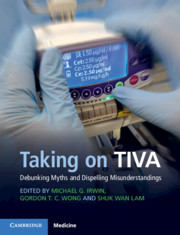Book contents
- Taking on TIVA
- Taking on TIVA
- Copyright page
- Contents
- Contributors
- Foreword
- Power to the People: the Rationale of a Practical Text
- Chapter 1 Why Bother?
- Chapter 2 You Say ‘PK’ and I Say ‘No Way!’; You Say ‘Keo’ and I Say ‘Time to Go!’
- Chapter 3 TCI and TIVA: What a Good Idea!
- Chapter 4 Milk of Amnesia
- Chapter 5 A Catwalk with a Difference
- Chapter 6 Let’s Get Started
- Chapter 7 Let’s Get Pumped!
- Chapter 8 ‘But I’m Used to MAC!’
- Chapter 9 Be Aware, Unaware and Confusion Everywhere
- Chapter 10 Do You Want Fries with That?
- Chapter 11 Intra- and Post-operative Analgesia for TIVA
- Chapter 12 Wakey Wakey!
- Chapter 13 Under Pressure
- Chapter 14 Ankle Biters
- Chapter 15 Old Timers
- Chapter 16 Big Can Be Beautiful!
- Chapter 17 A Bun in the Oven
- Chapter 18 Saving the Whales by Taking on TIVA
- Chapter 19 TIVA Drugs for Sedation
- Chapter 20 Skiing Off-Piste and Other Assorted Goodies
- Index
- References
Chapter 1 - Why Bother?
The Advantages of TIVA
Published online by Cambridge University Press: 18 November 2019
- Taking on TIVA
- Taking on TIVA
- Copyright page
- Contents
- Contributors
- Foreword
- Power to the People: the Rationale of a Practical Text
- Chapter 1 Why Bother?
- Chapter 2 You Say ‘PK’ and I Say ‘No Way!’; You Say ‘Keo’ and I Say ‘Time to Go!’
- Chapter 3 TCI and TIVA: What a Good Idea!
- Chapter 4 Milk of Amnesia
- Chapter 5 A Catwalk with a Difference
- Chapter 6 Let’s Get Started
- Chapter 7 Let’s Get Pumped!
- Chapter 8 ‘But I’m Used to MAC!’
- Chapter 9 Be Aware, Unaware and Confusion Everywhere
- Chapter 10 Do You Want Fries with That?
- Chapter 11 Intra- and Post-operative Analgesia for TIVA
- Chapter 12 Wakey Wakey!
- Chapter 13 Under Pressure
- Chapter 14 Ankle Biters
- Chapter 15 Old Timers
- Chapter 16 Big Can Be Beautiful!
- Chapter 17 A Bun in the Oven
- Chapter 18 Saving the Whales by Taking on TIVA
- Chapter 19 TIVA Drugs for Sedation
- Chapter 20 Skiing Off-Piste and Other Assorted Goodies
- Index
- References
Summary
Like many of you, we’re sure, we were trained to use IV anaesthetic agents for induction of anaesthesia but volatiles for maintenance – a sensible and seemingly safe combination that has been used for decades. So why change? The initial attraction of TIVA was the extremely rapid, smooth and clear-headed recovery of patients when using propofol as the hypnotic component of an anaesthetic. This is particularly apparent when the drug is used for cases of short to intermittent duration, for example in day-case surgery with earlier discharge from the post-anaesthetic care unit.[1] Clearly in modern practice, which is moving towards shorter in-patient stays, this represents a major advantage. In addition, improved levels of patient satisfaction occur with TIVA, presumably due to the favourable recovery profile.[2] Certainly, desflurane and sevoflurane allow rapid recovery but it is not as smooth, there may be more emergence delirium and quality indicators are not as good.[3]
- Type
- Chapter
- Information
- Taking on TIVADebunking Myths and Dispelling Misunderstandings, pp. 1 - 4Publisher: Cambridge University PressPrint publication year: 2019



